UNIT 4:EMPLOYEE RECRUITMENT PROCESS
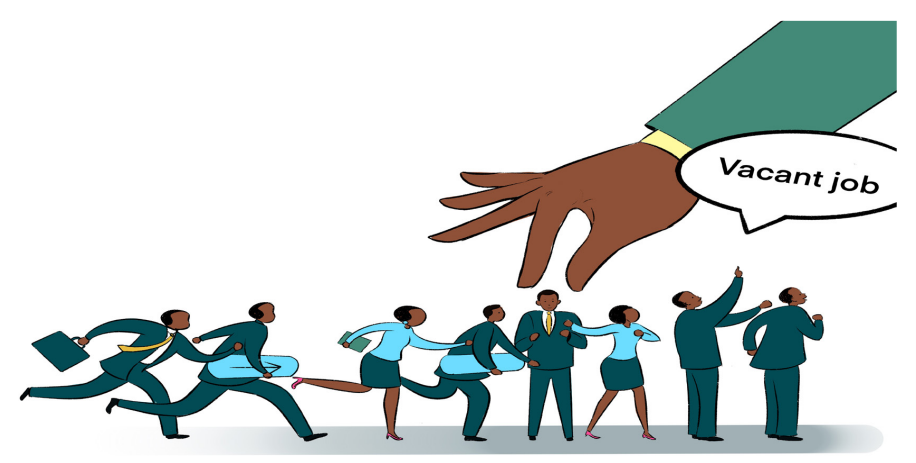
Key Unit Competence: To be able to design a strategy for recruiting
workers in their businesses and prepare for job opportunities in the community.
Introductory activity
1. Explain the meaning of employee recruitment and selection.
2. Explain any 3 factors considered while recruiting employees/workers.
3. Describe procedures/stages in recruitment process.
4. Identify required documents to apply for a job.
4.1 Meaning of recruitment and selection process,
and factors considered to recruit workers
Activity 4.1
1. Using clear examples, explain the meaning of the following
terms as used in entrepreneurship: a. Recruitment b. Selection process
2. Assume you are selected by a start-up business in your home locality
and appointed as a human resource manager to help in recruiting new employees,
explain factors you will consider while recruiting employees/workers.
4.1.1 Meaning of recruitment and selection process
Recruitment: Refers to the overall process of attracting, shortlisting,
selecting and appointing suitable candidates for job
(either permanent or temporary) within an organization.
According to Edwin Flippo: “Recruitment is the process of searching
the candidates for employment and stimulating them to apply
for jobs in the organization “. Recruitment is the activity that
links the employers and the job seekers.
• The process begins when new recruits are sought and
ends when the new employees are hired.
• The result is a pool of application forms from which
new employees are selected.
Selection : On the other hand is a process whereby out
of the many job applicants, the best is taken to fill the vacancy.
Selection means reducing down the application pool by
using the screening tools such as test, assessment centers,
background and reference checks. During selection of employees,
the choice can be on the candidates both from within
the organization or from outside.
Every organization creates a selection process because organizations
have their own requirements. Although the main steps remain the same,
let us understand in brief how the selection process works: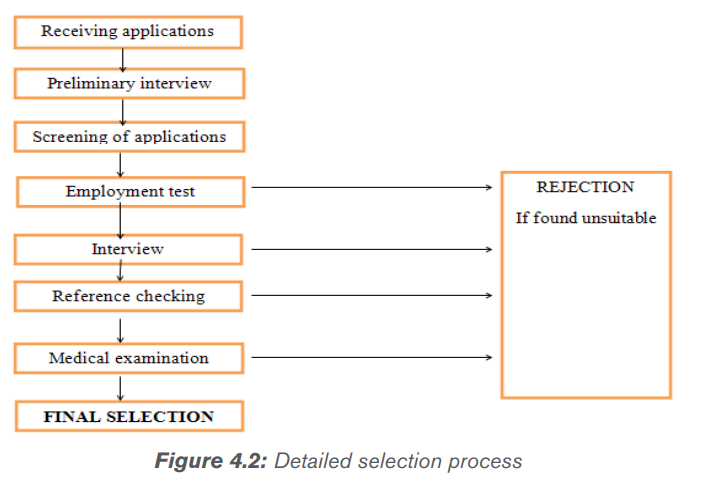
4.1.2 Factors considered when recruiting workers / em/ployee
a. Size of the firm: The size of the organization affects the recruitment process.
If the organization is planning to increase its operations and expand its business,
it will think of hiring more personnel which will handle its operations.
Size of the firm also defines the recruitment scope and need.
Small firm’s Human Resource department has to handle less manpower.
As the organization grows wider, the recruitment complexities increase.
Recruitment process would become more time-consuming and needs
more focus and large data processing.
b. Human resource needs: Staffing is an ongoing process that begins
with finding the right people through proper planning, recruiting,
and selecting. But staffing does not end once employees are hired;
management must keep and nurture its people via training,
appraising, compensating, and implementing employment decisions
that determine such things as promotions, transfers, and layoffs.
When recruiting new workers, you have to think about the prospective
human resource needs that may arise due to new hires.
c. Employment costs: These costs fall into several broad categories:
• Recruiting expenses: Finding technically qualified people who are effective
in a rapidly growing start-up venture is not easy task.
This is a one-time cost in the total employee cost calculation.
Recruitment costs include advertising, fees for online recruiting services, etc.
• Basic salary: Basic salaries vary all over the place depending
on the industry and a variety of other factors.
Be sure to establish rational salary ranges given your growth plans.
This means that in most cases there should not be great salary
differentials between early hires and later employees.
• Employment taxes: In preparing a personnel budget,
be sure to include all the employment related taxes
such as professional income tax.
• Benefits: Basic salary and employment taxes are not enough.
In most cases, an employer will need to provide some benefits
such as life insurance, dependent care assistance,
tuition reimbursement, accommodation, and
any other possible allowance where applicable.
d. Age of employees: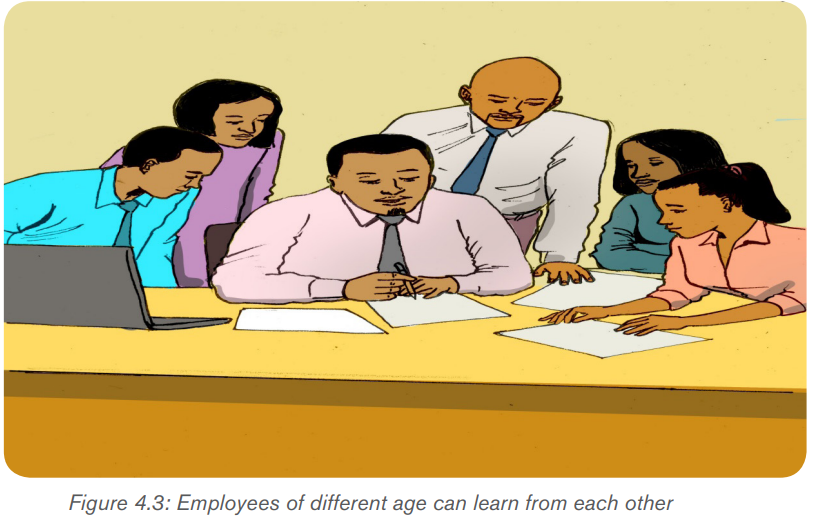
Age of the worker is a very important criterion
to consider during the recruitment process.
This is because some duties require workers with strong physical
abilities while some others require those with wisdom.
To help your young and old employees find common ground,
you need to treat them as individuals and not just as members
of certain generational categories. Help them realize that they can
learn from their differences; e.g. driving is suitable for young
while research requires experiences people (old).
e. Employees’ skills: One of the easiest ways to select through candidates
is by looking at their skillset. Can they do the job and can they do it efficiently?
Skill can be easy to measure based on the facts in front of you
(resume, cover letter and interview). It is true that some tend to fabricate or
“stretch” their experience so a solid approach to confirm skills is to contact
previous employers and verify if the skills communicated match up with what
the previous employer(s) saw. Of course, if the candidate lacks experience
they should communicate and express a desire to learn and pick up those skills.
f. Employee’s experience: Work experience might be one of the most important
considerations you have for particular jobs at your facility.
Experience in particular areas such as answering busy telephone
lines or handling accounts, for example, can be essential for specific staff roles.
For other positions, work experience might not be absolutely necessary,
but a strong work background is always a good thing as it exemplifies/illustrates a good work ethic.
g. Nature of job: The nature of an employee’s work is best defined as the type
of work that he/she does. This can refer to the basic daily tasks carried out as part of a job
and can refer to other non-routine tasks that may be required.
Added together, the characteristics of these tasks comprise
the nature of an employee’s work.
The nature of this work may be summed up in the employee’s title
and taken into consideration during the recruitment process.
For example, a human resources manager is someone who manages a human resources
department and performs all of the tasks required of such a position.
h. Number of workers: When one is recruiting employees,
he/she has to consider both the number
of workers needed and available qualified applicants.
The number of workers a business recruits depends on different criteria
most importantly the available vacant positions and its corresponding budget.
i. Health conditions: A lot of job applications have a section saying
«Do you have any existing or prior medical condition that may affect
your ability to do the job»? Employees with good health conditions
are liked by recruiters.
j. Language: The language is one of the effective communication drives.
A candidate who can effectively communicate as many languages as possible
is advantageous in the recruitment process.
Application activity 4.1
Assume you are selected as one of the school business club leaders,
and you have a very strong income generating project at your
Teacher Training Center. Advise your business club on factors
to consider when recruiting employees.
4.2 Procedures/ stages of recruitment process of workers
Activity 4.2
Case study:
Umutoni, a human resource manager of Sweet bread bakery
was having the challenges of getting a suitable finance manager for the company.
She was advised to prepare job analysis. Furthermore, she was advised
to prepare a job description which outlines the responsibilities
and duties to be carried out by the financial manager.
Umutoni was also advised to prepare a job specification
which outlines the requirements, qualifications, expertise,
physical characteristics, for the financial manager.
All these were to appear on the job advert.
The task was so challenging, but she managed to come up with the documents,
and a suitable financial manager was got after the selection and interviews.
a. Describe the following stages as involved in recruitment process:
i) Job analysis
ii) Job description
iii) Job specification
iv) Job advertisement
b. Why do you think it is important to prepare the above documents?
If an organization needs to hire right employees, the following
stages should be put into consideration:
a. Conduct a job analysis: Job analysis involves establishing the nature of the job
(tasks, activities, responsibilities, and accountabilities)
which will also determine associated required talents
and competencies defining behavioral attributes for best performance.
A personnel manager has to undertake job
analysis to recruit the right person on the job.
b. Create a job description: Job description is a process of describing
the job to be performed. This is also referred to as a written statement
which outlines the duties and responsibilities involved in performing
a job such as who does what, when, where and why.
The main contents are the job purpose and the job tasks and responsibilities.
It informs employees exactly what is expected of them and provides
a useful document to refer to when you are evaluating an employee’s performance.
You can also use it to develop selection criteria,
identify training needs, and manage performance.
Example of a job description for a finance manager:
Main purpose of the job:
• Responsible for bookkeeping, auditing and
making financial reports for the business.
• Responsible for accountants, cashiers and workers
in the finance department. To take a supervisory role.
Main duties:
• Preparing pay rolls .
• Making financial reports for external auditors
and other stake holders.
• Advise the general manager and the managing
directors on financial issues.
• Supervise the subordinate staff .
• Advising staff when queries arise.
Occasional duties:
• Appointment of new staff.
• Training new staff in their duties.
• Training new staff on how to use new equipment.
Disciplining staff as and when required.
• Dismissing staff if necessary.
c. Create a job specification:
Job specification involves a definition of qualifications,
experiences and competencies required by the jobholder
and any other necessary information on the special demands made by
the job such as physical conditions, unusual hours or travel away from home.
Job specification sets out terms and conditions of employment such as pay,
employee benefits, general health, mental health, intelligence, aptitude,
memory, judgment, leadership skills, emotional ability, adaptability, flexibility,
values and ethics, manners and creativity, etc.
Example of a job specification for a financial manager:
Qualifications
Essential: Bachelor’s degree in finance and accounting.
Master’s degree in a related field will be an added advantage.
Experience:
Desirable minimum is 5 years’ experience of working in the finance department.
Skills:
• Communicating effectively with others.
• Ability to manage people.
Others
• Physical fitness, needs to be fit all day.
• Personal characteristics: Honest and responsible, friendly, helpful, organized, high integrity, etc.
• Computer literate with computerized accounting software packages e.g. Sage or Quick books.
d. Defining a job position:
This section contains providing general information about the job position.
The current or requested classification, working title, pay range,
exemption status, department name and number, position number,
percentage of effort, the job description summary, comparable positions, etc.
This is all about what responsibilities you might have.
e. Attracting the applicants (Job advertisement): Job advertising is a way organizations
communicate to attract new employees to work with them.
Recruitment advertisements typically have a uniform layout
and contain the following elements:
• Brief description of the organization.
• The title of the job advertised, the grade and
the manager to whom the job holder will report.
• Duties and responsibilities of the job holder.
• Skills and competences of the job holder.
• Conditions of educational qualification and
experience of that job position holder.
• The channel of communication used
for submitting the application.
• The timeline during which applications will be submitted.
• The channel of communication for feedback.
• Signature and the stamp of the organization manager
who is posting the advertisement. Some business organizations
use recruitment advertising agencies to receive professional
advice and also help them to recruit new workers.
They offer a service which they are paid for in return.
Examples of recruitment agencies in Rwanda include:
- Tohoza.com - Umurimo.com
- Jobs in Rwanda - NFT consult
- Ndangira.net
f. Selection: This is the process of getting human resources
into organizations’ departments, sections and jobs.
Human Resource Managers are responsible for recruitment
and selection which should be clear on the type of employees they are looking for.
Lack of clarity may lead to poor selection criteria and may result
in the wrong person being recruited for the job.
There are important steps in the process for effective
competence-based selection:.
• Development of competence models for selection.
• Determination of selection methods.
• Training of assessors.
• Assess job applicants.
• Validate the assessment methods.
• Development of a database for future use.
g. Hiring: After successfully completing all the previous stages,
an appointment letter will be issued by the employer to the worker.
A reference check is made about the candidate selected and
then finally he/she is appointed by giving a formal appointment letter.
h. Integrating the new employee to the organization/Orientation:
On-boarding helps to foster a positive first impression and increases
the likelihood that employees will buy into the corporate culture
and assimilate into the position. Properly executing the orientation
process can greatly increase the new employee’s satisfaction and
success, which bodes/ promises well for retention.
The following are essential five steps to effectively on board
new employees to your organization:
• Prepare the office for the new arrival
The first day on the job should be organized and scheduled
before the new workers come. Managers should build out a schedule
in advance that includes learning the job in particular and company policy
and process in general. Share this agenda with your new hire in advance.
Also, send a copy to all team members involved with the on -boarding process.
• Assign a mentor
One of the best facilitation strategies for on boarding is mentor relationship.
Mentors provide guidance that goes beyond traditional training.
Match up a seasoned employee with the new hire in the early stages of training.
A mentoring relationship will prove invaluable
to the new employee’s integration into the workplace.
• Make positive introductions a priority
Create good will toward the new hired by introducing
them to the current team with a short explanation
of the person’s expertise and qualifications.
This type of introduction helps current employees become familiar
and acceptance of the new person. Also, avoid statements that
create competitive or insecure feelings.
• Request feedback from new employee
Consistent feedback from the new employee is valuable
in knowing which facets of the on-boarding process work
and which ones need to be improved. Periodically,
ask for input on the training process, and measure its effectiveness.
• Provide a cohesive goal
From the beginning, every new employee or seasoned should understand
the company goals along with his or her specific tasks.
A common goal serves to create greater collaboration and harmony.
Facilitation strategies for integrating new employees require planning and follow-up.
The results bring a more engaged, dedicated employee and fewer workplace conflicts.
Application activity 4.2
1. Design a job description for one of the following;
a. A school business club cashier
b. Shop assistant
2. Design a job specification for your chosen job.
3. How do a job description and job specification help
to ensure the most suitable person for the job is recruited?
4.3 Required documents to apply for a job
Activity 4.3
1. TUYISHIMIRE is a senior six graduate. Having learnt about a job
advert by INYANGE Industries (a famous manufacturing company in Rwanda),
posted in the new times has approached you a fellow student for advice,
advise her pointing out the requirements to apply for the job.
2. a) Identify the difference between a curriculum vitae
and an application letter?
b) Identify the major parts that good curriculum vitae should have.
To prove that you are eligible for work and to apply for a job,
the following are some of the documents you will have to submit:
4.3.1. Application letter:
Writing an application letter will be the first correspondence
you are going to have with your possible employer.
The employer will definitely judge you on your application
letter if you are worthwhile being interviewed.
Always remember that any job competition is very tough.
Therefore, your application letter must stand out because employers
usually deal with hundreds of job applications for a single position.
Start your letter by adding your contact information at the top.
You want to make it as easy as possible for your prospective
employer to contact you and know who you are.
Before you begin your letter, make sure that you have the proper letter-head.
i) Name
ii) Address
iii) Phone number
iv) Email address
v) Personal website (if you have one)
• Include the company’s information: After you include your information,
you need to include the title of the employer to whom you are applying for the job,
the name of company and address. By including the contact information
of the company to which you are applying, you are showing that
you have taken the time to write a specific letter or application
to this company, and have done your research on the hiring manager for the position.
• Address your letter to the person whom you are writing:
To begin your letter, you want to be formal and start with a proper/correct address.
Once again, a simple “Dear Manager, Director”, etc. This will depend
on the information given from the advertisement.
• Salutations: These are greetings used in a letter; e.g. Dear Sir, Dear Madam.
• Subject line: This indicates the title or the position being applied for.
• Body of the letter: This has three distinct parts:
- In the first paragraph, you have to mention the job you are applying
for and where you saw the job listing.
- The next paragraph(s) are the most important part of your letter.
Remember how you gathered all that information about what employers
was seeking, and how you can meet their needs.
This is where you will share those relevant details
on your experience and accomplishments.
- The third and last part of the body of the letter will be your word
of appreciation to the employer; and you can also offer follow-up information.
• Complimentary close: Complete your letter with a polite close,
such as «Best» or «Sincerely, » followed by your signature and your name.
Notice: When you apply online through E-Recruitment;
follow the structure/ format provided to you.
Sample hint of an application letter
Name Address
Telephone number
Email Address
Month, Day, Year
Title of the authority receiving the application
Name of Organization
P. O. Box Address
Dear Mr. /Ms. /Dr. General Director
Subject line: Include the title /position you are applying for
Opening paragraph: State what position you are applying
for and a brief introduction about yourself;
how you learned of the organization or position,
and basic information or qualifications about yourself.
2nd paragraph: Indicate why you are interested in the type of work;
demonstrate that you know enough about the position
to relate your background to the position.
Mention specific qualifications which make you a good fit for the employer’s needs.
This is an opportunity to explain in more details relevant
items in your CV/resume. Refer to the fact that your CV/resume is enclosed.
Mention other enclosures if such are required to apply for a position.
3rd paragraph: Indicate briefly why you’re so passionate about the opportunity
you’re applying for. State that you would be glad if you are granted a job.
Thank the employer for her/his consideration in advance.
Sincerely,
(Your handwritten signature)
Your name typed
SAMPLE APPLICATION LETTER
Kigali City
Gasbo District
Kimironko Sector
Email: buteja@gmail.com
Phone: +250783344560
15th October 2019
To: Director of Rwanda
Microfinance Ltd Kigali
Dear sir/Madam,
Re: Application for job on position of cashier
I would like to apply for the position of cashier as per your advert
in Imvaho nshya no: 2345-4-2019 in the institution which is under your responsibility.
In fact, I am a young Rwandan of 25 years of age and I am an A2 certificate holder in Math,
Economics and Geography. As you can see from my curriculum vitae,
I have had two years experiences of working in that field such as education
and financial institutions. I work well in team on daily basis
and I am eager/enthusiastic to contribute to the growth of your institution too.
Although no specific IT qualification, I do have necessary key board skills
and necessary knowledge of the soft-ware that you use.
I am most interested in the situation that you are offering
and look forward to hearing from you.
Yours sincerely,
Signature
BUTERA Jane
4.3.2. Curriculum Vitae (CV):
The letters CV stand for curriculum vitae which in Latin means “Course of life”.
When used in a job seeking context, a CV is a brief history of your education,
work experience and activities, skills, accomplishments and
any other information relevant to getting a job.
A.CV writing and format tips:
i) Include relevant information only: Your CV should not include all
details about your life. Keep it simple, clear and neat.
ii) CV Length: While resumes are generally one page long, CV is longer.
Most CV are at least two pages long, and often much longer.
iii) Font and Size: Do not use ornate/decorative fonts that are difficult to read;
Times New Roman, Arial, Calibri, or a similar font is best.
Your font size should be between 10 and 12 points,
although your name and the section headings can be a little larger and/or bolded.
iv)Format: However, in deciding to organize the sections of your CV,
be sure to keep each section uniform.
For example, if you put the name of one organization in italics,
every organization name must be in italics.
If you include a sentence or two about your accomplishments in a position,
fellowship, etc., make a bullet list of each accomplishment.
This will keep your CV organized and easy to read.
v) Be accurate: No spelling or grammatical errors.
Be sure to edit your CV before sending it.
Check spelling, grammar, tenses, names of companies and people, etc.
Have a friend or career services counselor check over your CV as well.
vi)Be consistent: Punctuation, highlighting, verb tense, spacing etc.
should be verified.
vii) Spells out acronyms: The first time it appears,
put the acronym in parentheses and then use the acronym after that.
B. Elements of Curriculum Vitae
Not all curriculum vitae look the same.
But there are general sections that have to be included in almost all CVs.
However, one may choose to include only some sections because
others do not apply to his/her background or industry.
Include what seems appropriate for your area of specialty. In your CV you can include:
a. Contact information: At the top of your CV, include your personal
identification/name and contact information (address, phone number, email address, etc.).
b. Education background: This may include the school/institution
attended, dates of study, and degree received.
c. Work Experience: List relevant work experience;
this may include nonacademic work that you feel is worth including.
List the employer, position, and dates of employment.
Include a brief list of your duties and/or accomplishments.
d. Skills :
- Professional competencies relevant to the position for which you are applying.
- Computer skills.
- Language skills, etc.
e. References: In this part, include people who know you
and who might be contacted in case they need any information about you.Lastly, end by certifying that the information is from the best of your knowledge.
Below is a sample of curriculum vitae (CV)
Curriculum Vitae
1. PERSONAL IDENTIFICATION
• Names: BUTERA Janet
• Date of Birth: 8/12/1995
• Gender: Female
• Nationality: Rwandese
• Marital status: Married
• Telephone: (+250) 738469764
• E-mail: butejane@yahoo.fr
• Contact address: P.o.Box 1010
Bugesera District
Eastern Province – Rwanda2. EDUCATION BACKGROUND
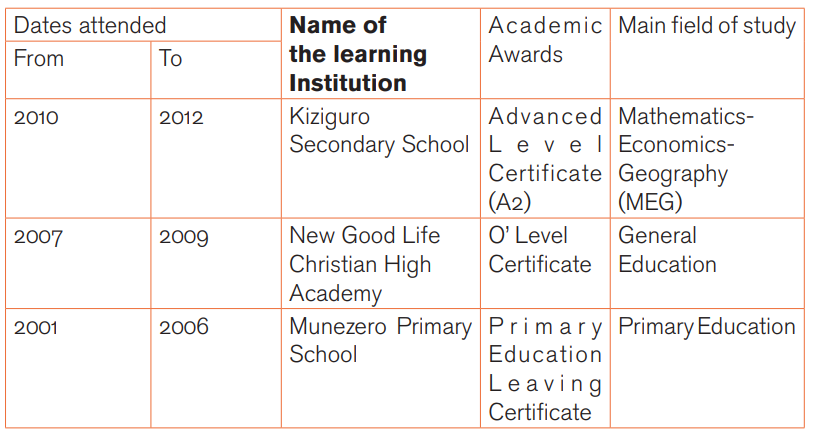
3. PROFESSIONAL EXPERIENCE
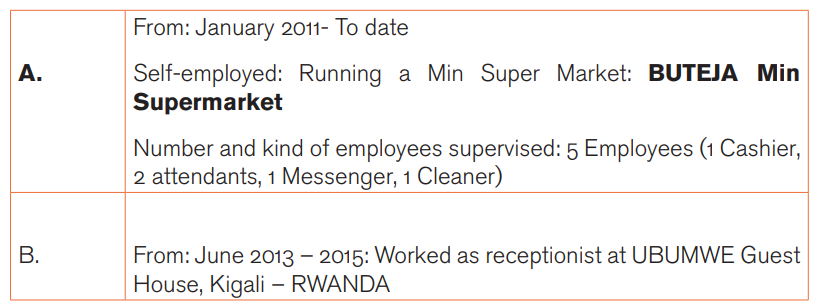
4. OTHER SKILLS ACQUIRED

5. LANGUAGES

6. HOBBIES

7. REFEREES

I, BUTERA Janet do declare that the above information is true to the best of my knowledge.
BUTERA Janet,
The manager,
BUTEJA Min Supermarket
4.3.3 Academic credentials/ relevant qualification papers
Credentials often refer to academic or educational qualifications,
such as degrees or diplomas that you have completed or partially-completed.
Credentials can also refer to occupational qualifications,
such as professional certificates or work experience.
These are examples of academic credentials:
• Secondary (high) school diploma
• College diploma
• Bachelor’s degree
• Master’s degree
• PhD or Doctorate degree
• Professional school degree (for example, for law, medicine, teaching)
A few organizations evaluate international academic credentials
to compare them to credentials you can get in your country.
You may need this for work or if you apply to a college, university or institute.
Application activity 4.1
Assume you want to apply for a post in any business company.
• Design an application letter
• Design your curriculum vitae.
Skills Lab
Bright Business club wants to expand by introducing other viable projects.
In efforts to ensure the club grows effectively, they will recruit a strong
marketing manager from one of the members in the club.
The key role of the marketing manager is to ensure the right
projects are implemented in the club.
1. As student teachers of entrepreneurship,
create a relevant job specification and make an
advert for the above position.
2. Discuss the importance of creating a job
specification for a given position.
End of unit assessment
1. You have come across an advertisement on the internet
about the need for Head of Security in a prominent shop.
Write an application letter to apply for the above post.
2. Gikundiro is a senior six level student who wants to start
a fruit processing business and she needs help from you to design
an advert for various posts in a fruit processing business.
